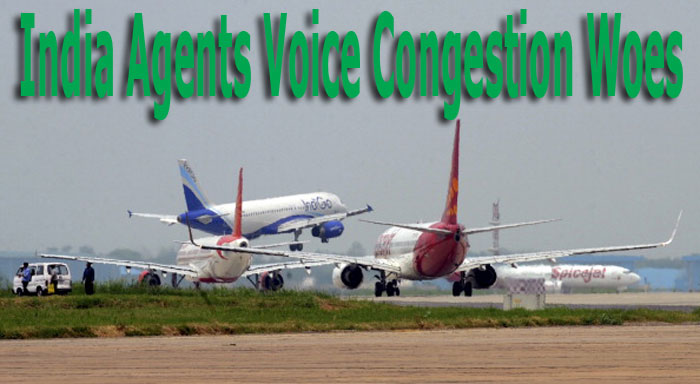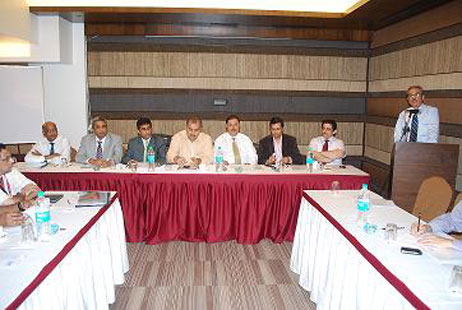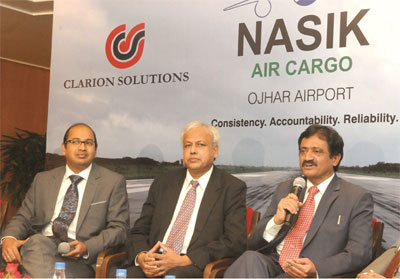
Fed up with the congestion
problems in Mumbai airport—and of late, the situation has gone
from bad to worst—freight forwarders and air cargo stakeholders
can look forward to air cargo services at the Ojhar airport in Nasik
in Maharashtra. The airport initially expects about 20-25 percent
of the 40,000-ton monthly cargo handled at the Mumbai airport to come
to it.
 The
ACAAI and the Bombay Custom House Agents Association meeting in progress.
ACAAI President Bharat Thakkar is seen addressing the members of the
two trade bodies. The
ACAAI and the Bombay Custom House Agents Association meeting in progress.
ACAAI President Bharat Thakkar is seen addressing the members of the
two trade bodies.
At the beginning of September,
in a move that could only be the result of frustration and delays,
the Air Cargo Agents Association of India (ACAAI) along with the Bombay
Customs House Agents Association of India held a joint meeting to
let the authorities know about their problems. ACAAI President Bharat
Thakkar detailed the long list of grievances faced by air cargo stakeholders.
He said that the Mumbai International Airport had taken over the Air
Cargo Complex from the government-controlled Airports Authority of
India in 2006.
“Since then,” he told ACNFT,
“there has been a manifold increase in the volume of cargo.
However, there has been no improvement in the infrastructure, manpower,
equipment being provided to the trade.”
Over the last five years, many suggestions
to enhance and upgrade the infrastructure have been made, but little
has been done. “The trade was promised state-of-the-art cargo
facilities, but even until today, that promise remains a distant dream,”
said Thakkar.
He also said that while the airport
handled 30,032 tonnes in March this year, from April onwards there
was a fall: 27,092 tonnes in April; 28,936 tonnes in May; 26,179 tonnes
in June; and 28,394 tonnes in July. All this pointed to the fact that
cargo was going away to other airports.
 Announcing
the start of cargo operations from Nasik's Ojhar airport: (L-R) Ganesh
Krishnan, CEO, Clarion Solutions (Clarion is a subsidiary of Transworld
Group, a leading coastal shipping operator in the country); V. Ramnarayan,
Vice-Chairman, Transworld Group of Companies; and P. V. Deshmukh,
MD, Hindustan Aeronautics. Announcing
the start of cargo operations from Nasik's Ojhar airport: (L-R) Ganesh
Krishnan, CEO, Clarion Solutions (Clarion is a subsidiary of Transworld
Group, a leading coastal shipping operator in the country); V. Ramnarayan,
Vice-Chairman, Transworld Group of Companies; and P. V. Deshmukh,
MD, Hindustan Aeronautics.
It is apparent now that exports and
imports will need to move barely 200 km to go from Mumbai to Nasik’s
Ojhar, which is being promoted primarily as a cargo airport. Begun
by HALCON, a joint venture working group between Hindustan Aeronautics
Ltd. (HAL) and the Container Corporation of India (Concor), along
with terminal operator Clarion Solutions, Ojhar’s cargo services
were announced recently. The airport is well equipped and capable
of handling heavy aircraft like the Russian AN-124. The infrastructure,
developed by Hindustan Aeronautics Ltd (HAL) at Ojhar, will now be
utilized for export and import activities by facilitating air cargo
services.
Speaking at the commencement of air
cargo services, Ganesh Krishnan, CEO, Clarion Solutions, pointed out
that Nasik had the potential to develop as a hub for air cargo services
in western India. Situated at the center of various industry verticals
and its proximity to the main highway linking Mumbai and Delhi, Ojhar
airport could be a viable alternative solution for the export-import
trade, he said. “Ojhar going operational for air cargo services
will act as a cost effective and single-window clearance facility
for the importer and exporter community. It will also help in decongesting
the existing air cargo complexes that are presently struggling for
the desired space in and around the state,” Krishnan added.
According to P. V. Deshmukh, Managing
Director, Hindustan Aeronautics, HAL had invested nearly Rs 70 crore
to upgrade the existing infrastructure—the airport has been
in existence since 1964 primarily for HAL, which manufactures small
aircraft and helicopters—like creating additional parking space
and making it a desired destination for air cargo services. Along
with night landing facilities, Ojhar comprises a full-fledged air
cargo complex, warehousing, integrated packing center for perishables,
cold storage, screening, unitizing/palletization, comprehensive ground
handling services for airlines, CCTV surveillance, bar-coding, labeling
and Customs with EDI linkage. Deshmukh also said that Ojhar airport
would be dedicated for air cargo services and help decongest the traffic
at Mumbai airport. It would help exporters of vegetables, flowers,
fruits, automobile, pharma, and engineering products. All in all it
would benefit the large number of industrial giants situated in the
region.
With better road and rail connectivity,
Ojhar airport will act as a cost-effective platform for the importer
and exporter community from industry segments such as agriculture,
manufacturing, pharma, engineering, automobile, FMCG, etc., operating
in the western belt of the country. These industry segments will now
be able to utilize the air cargo services at Nasik, reducing the uncertainties,
like delivering the goods in defined timelines, while using road and
rail transport. Through Ojhar airport, customers (importers, exporters)
can optimize on costs, as they need not wait at the borders and deal
with restricted movements and congested roads.
Tirthankar Ghosh
|





